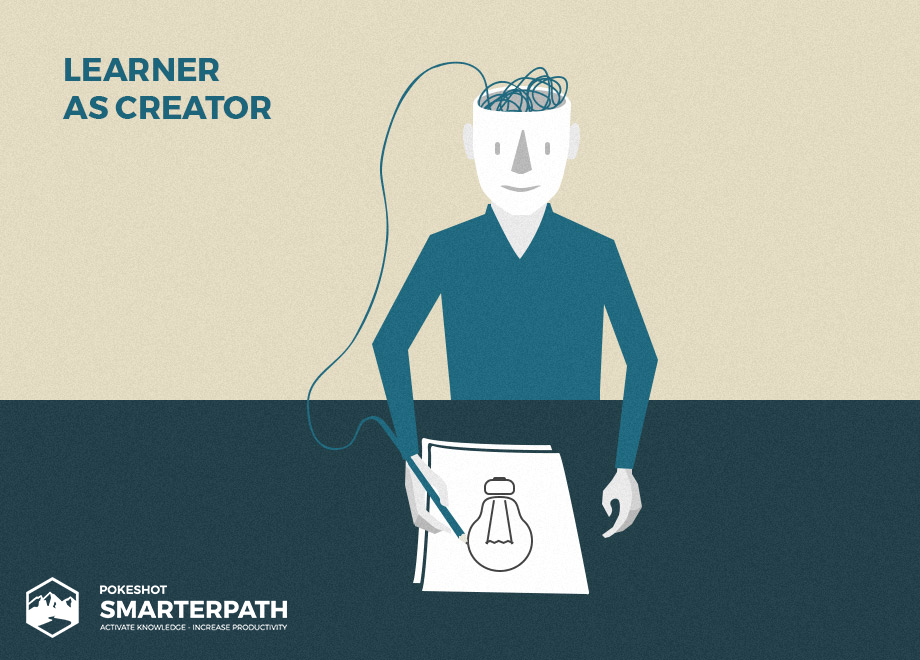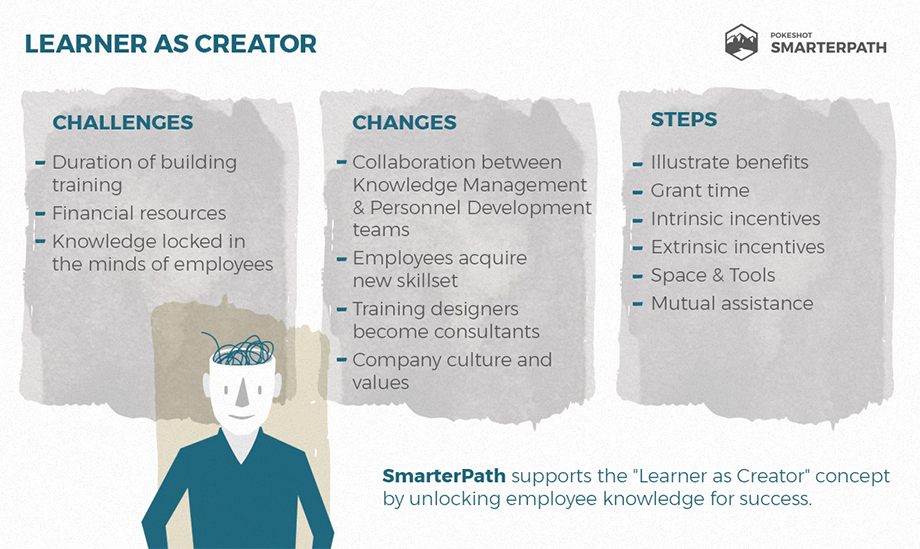How do you train your employees when it comes to company-specific and interdisciplinary topics? How do you ensure that current knowledge is transformed into valuable learning content swiftly? We discussed these questions at the Knowledge Camp session in Potsdam. The following blog post gives reasons for implementing the concept of “Learner as Creator.” We discuss the first ideas for organizational actions and changes necessary in companies in order to succeed.

The topics that companies must deal with nowadays are becoming more and more complex and hardly any particular expertise can be attributed. Collaboration across disciplines increases and routine work decreases. This leads to difficulties in standardized distribution of knowledge. The process for specific knowledge to be passed from one or even several experts to a third party can take months. The third party has to pack it, prepare it, collect feedback and then make it available online or offline. In the worst case, the training that has been created is already out of date at the time of completion. In addition, small and medium-sized enterprises often do not have the financial resources for costly professional training.
The knowledge of the processes, products and services of your core business is in the minds of your employees and thus in the company. Nowadays almost all knowledge workers have a smartphone or a laptop. So why not go directly to the source and enable employees to transform and share knowledge independently into valuable and sustainable learning content? Make learners become trainers and achieve better results in the language of the consumers. Like all new approaches, it also needs to be accompanied by appropriate change management.
It is essential for knowledge management and personnel development to work closely together. The challenges of knowledge management, like avoidance of knowledge silos and use of existing information must also be actively picked up by personnel developers. In the same way, knowledge management has to support the quick and easy preparation of high-level and dynamic knowledge. There should not be a strict separation, rather a fusion of both areas. Interdisciplinary problems need interdisciplinary solutions.
In order to enable knowledge workers to create high-quality learning content they must acquire a new skillset. This includes, among other things, the correct use of the software and preparation of knowledge into clear and memorable content. Existing training designers will turn into consultants for knowledge workers. Their task is to provide consistent and valuable trainings on the basis of best practices. Smaller companies that do not have internal training experts can identify multipliers, who act as contact people and supporters for the administration and preparation of learning content. A small policy or guide that is developed by a project group with different stakeholders can also help.
You may also hear from employees: “Another task? I don’t have time for that!”. This intelligible argument must be countered at a higher level. As for many organizational changes, company culture as well as values in terms of learning and knowledge play a decisive role. How does knowledge sharing get evaluated in your company, in your team? Is it seen as a waste of time or as added value? What do team members get appreciation for? Does anyone take the time to actually evaluate shared content and reuse it? In our blogpost about “Is Digitalization really digital” you can read further how other companies have adopted this change.
The cultural change that is needed for the concept “Learner as Creator” does not take place today or tomorrow or even by itself. Rather, a conscious decision must be taken actively and then controlled in a desired direction. The following framework conditions and measures can support change:
- All stakeholders should be included and engaged to participate in the discussion early, where they can best see the benefits for themselves.
- Time for the preparation and consumption of knowledge during working hours should be granted, e.g. 1h per week for each employee
- Intrinsic incentives for sharing knowledge strengthened, e.g. through appreciation, recognition and praise for contributions
- Additional extrinsic incentive systems for sharing knowledge are created, e.g. as a component of goal agreements or gamification approaches
- Spaces and tools for exchanging current topics are provided, e.g. online and offline communities as well as learning software, that are at best integrated into the workplace and existing toolsets
- Assistance in the implementation by experienced knowledge workers, e.g. by helping to create a video or blog post
In the open discussion on “Learner as Creator” at the Knowledge Camp in Potsdam, the fear of loss of quality was highly discussed. Of course it is more authentic if Joe Employee shoots a selfie video of himself assembling a machine, but if it is poorly directed no one will learn anything about the topic. It should be emphasized that the inclusion of employees in the preparation of learning materials in small steps is possible and meaningful. Not every employee has to design complete training courses but they should support those regarding their respective field of expertise: what needs to be learned, what is important to co-workers, what questions are frequently asked, where are the problems? Training developers can take this content and (if it is good) integrate it directly or upcycle it. In our blogpost about upcycling you can learn what you have to consider.

These are only a few suggestions from our side, on how the 70% practical experience as well as the 20% knowledge that we acquire in the professional environment can be transformed into 10% structured learning. Get familiar with the 70-20-10 method in our blogpost! SmarterPath supports the concept of “Learner as Creator” by embedding it into the familiar work environment (Jive or O365), simple user guidance without complex software training and the possibility of re-using existing knowledge. In a following blog post you will get to know how we tested the concept at Pokeshot internally on a specific example using SmarterPath.
View Part 2: Learner as Creator
If you have any questions or need help with your internal change management, please don’t hesitate to contact us!
We are sure you have more ideas, please share them in the comments!
 Linda joined Pokeshot GmbH in March 2016 as a consultant for social collaboration and learning management. Her primary responsibility is the product management of our award-winning social learning solution SmarterPath.
Linda joined Pokeshot GmbH in March 2016 as a consultant for social collaboration and learning management. Her primary responsibility is the product management of our award-winning social learning solution SmarterPath.
Connect with us on facebook | twitter | LinkedIn | YouTube – we will keep you posted!
1 thought on “Learner as Creator – Unlocking Employee Knowledge for Success”